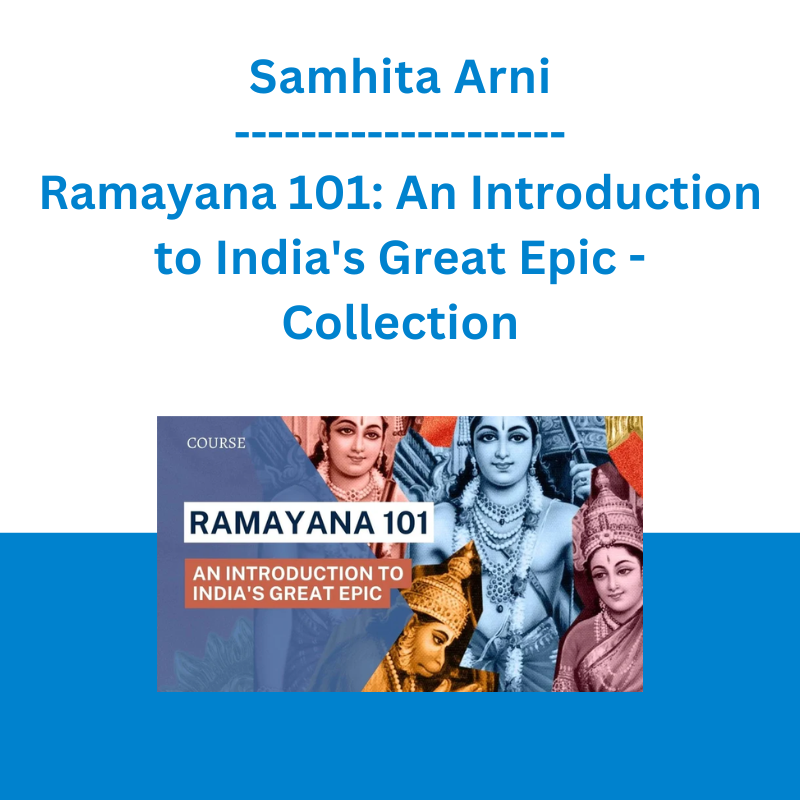*** Proof of Product ***
Exploring the Essential Features of “Samhita Arni – Ramayana 101: An Introduction to India’s Great Epic – Collection”
About
The Ramayana, an ancient epic based in thousands of years of tradition, still captivates our popular imagination. In India, court judgments refer to the Ramayana, while advertisements frequently depict the ten-headed villain of this epic, Ravana. The main hero and heroine of the epic, Ram and Sita, are still spoken of as ideals and role models, used to prescribe the way men and women should live and relate to each other. This epic tradition has constructed and mediated relationships between god and man, man and woman, ruler and subject, poet and patron.
The Ramayana has been retold countless times over millennia – in art, performance, and in words – with each storyteller inscribing their own life experience onto the epic and reinterpreting its legacy for subsequent generations. In this course, we will examine how this epic tradition and its complex legacy influence ideas of life, leadership, power, and romantic relationships in India and beyond. The epic tradition still influences the culture, lifestyles, and beliefs of the Hindu diaspora, from the US to Guyana.
This course is designed to accommodate all levels of understanding, including curious non-Hindus who seek to understand the impact that this story has had on Hindu perspectives, history, and culture and enable them to perceive the continuing legacy of this epic today.
Module 1: Introduction to the Ramayana
The purpose of this module will be to understand the themes, characters, and basic plot of the story, by looking at different visual interpretations of the epic across time. Examples will include the artwork of the nineteenth-century artist Raja Ravi Varma, as well as temple sculptures and the imagery of Ramayana TV series in the 1990s.
Module 2: Ram and The Ramayana
In this module, we will take a deeper look at the character of Ram: The exiled prince, the Good King. Ram, as the “maryada puroshottam”, ideal man, has been instrumental in the way kingship, has been defined, in South and South East Asia. We will also look at Ram as an epic hero and understand what he shares with other epic heroes (such as Odysseus) and how his journey reflects the stages of Joseph Campbell’s The Hero’s Journey.
Module 3: Sita and the Many Versions of the Ramayana
In this module, we will examine the character of Sita and how she has been interpreted in the various versions of the Ramayana. If time permits, we will also look at the other female characters of the epic to understand more deeply, how the epic has shaped gender roles.
Module 4: The Storyteller and Society
In conclusion, this module will examine how storytellers across time have woven themselves into the fabric of the story. A core aspect of every Indian epic is the presence of the sutradhara, the storyteller, who is part of the story he or she tells, and projects their own time and lived experience onto the story. For example, we will see how Valmiki, the author of the Valmiki Ramayana, is not just a poet – but also a character within the story he tells. We’ll look at how storytellers who are ‘excluded’ – women or from marginalized caste – approach the Ramayana in the context of their own lived experience and seek to reclaim the story.
Participants in this course will learn:
Understand the Ramayana as a tradition, a multiplicity of narratives.
Study the impact of this tradition on history, the idea of kingship and power paradigms in South Asia, and reflect on the role that epics and literary traditions play in the cultural and political imagination.
Gain an understanding of how the Ramayana reflects and has helped form, archetypes, and a cultural narrative in the Indian context, which includes exploring how the Ramayana impacts lived relationships, caste, and gender roles.
Examine the relationship between the sutradhar, the storyteller (the reteller of the Ramayana, in this context), and the society they live in, and understanding that can be extrapolated to other literary traditions.
Author
Samhita Arni
When she was eight, Samhita Arni started writing and illustrating her first book. The Mahabharata – A Child’s View went on to be published in seven language editions and sell 50,000 copies. Samhita’s second book, Sita’s Ramayana, a graphic novel developed in collaboration with Patua artist Moyna Chitrakar, was on the New York Times Bestseller list for Graphic Novels. She is also the author of the speculative-fiction mythological thriller, The Missing Queen. The Prince, her fourth novel, recently won the 2019 Neev Book Award. Samhita lives in Bangalore with two cats and teaches creative writing at the Srishti Institute of Art, Design and Technology.
Please see the full list of alternative group-buy courses available here: https://lunacourse.com/shop/










 Ed Ponsi - Forex Trading
Ed Ponsi - Forex Trading  Oliver Velez - Essential Strategy Of Trade For Life
Oliver Velez - Essential Strategy Of Trade For Life  Crypto Dan - The Crypto Investing Blueprint To Financial Freedom By 2025
Crypto Dan - The Crypto Investing Blueprint To Financial Freedom By 2025  Julie Stoian & Cathy Olson - Launch Gorgeous - Funnel Gorgeous Bundle
Julie Stoian & Cathy Olson - Launch Gorgeous - Funnel Gorgeous Bundle  SMB - Options Training
SMB - Options Training  George Fontanills & Tom Gentile - Optionetics 6 DVD Series Home Study Course (Digital Download)
George Fontanills & Tom Gentile - Optionetics 6 DVD Series Home Study Course (Digital Download)  Simpler Trading - Bruce Marshall - The Options Defense Course
Simpler Trading - Bruce Marshall - The Options Defense Course  Matan Feldman - The 13-Week Cash Flow Modeling - Wall Street Prep
Matan Feldman - The 13-Week Cash Flow Modeling - Wall Street Prep  Team NFT Money - Ultimate NFT Playbook
Team NFT Money - Ultimate NFT Playbook  Alphashark - The AlphaShark SV-Scalper
Alphashark - The AlphaShark SV-Scalper  Jesse Livermore Trading System - Joe Marwood
Jesse Livermore Trading System - Joe Marwood  Forexmentor - Recurring Forex Patterns
Forexmentor - Recurring Forex Patterns  Fred Haug - Virtual Wholesaling Simplified
Fred Haug - Virtual Wholesaling Simplified  The Daily Traders – Exclusive Trading Mentorship Group
The Daily Traders – Exclusive Trading Mentorship Group  Chris Capre - Advanced Price Action Ongoing Training & Webinars
Chris Capre - Advanced Price Action Ongoing Training & Webinars  Trade Like Mike - The TLM Playbook 2022
Trade Like Mike - The TLM Playbook 2022